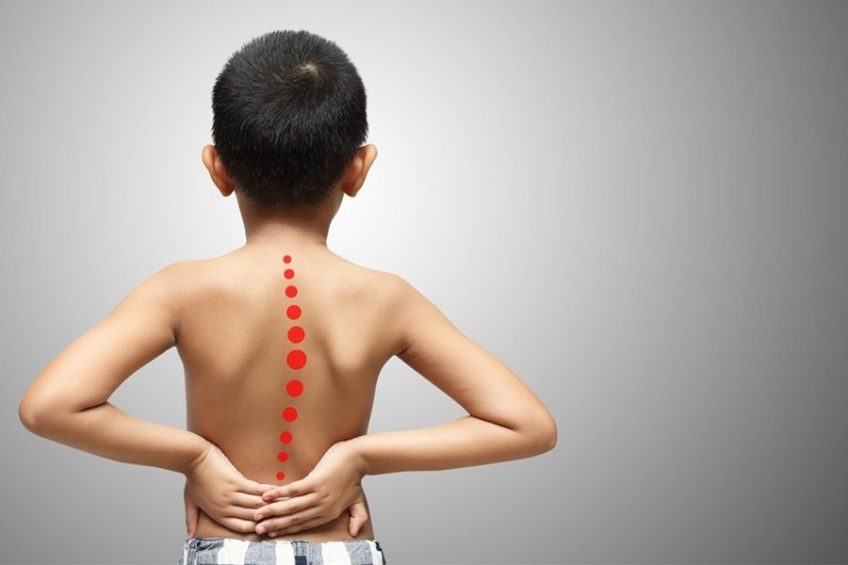Kyphosis in children is manifested by excessive curvature of the spine in the thoracic region, being compensated by a cervical and lumbar hyperlordosis to balance the spine.
Kyphosis is a deviation of the spine in the sagittal plane (in the vertical plane of symmetry), by exaggerating the normal curves of the spine.
CONTENT:
- Causes of kyphosis in children
- Symptoms of kyphosis in children
- Types of kyphosis in children
- Treatment of kyphosis in children
Causes of kyphosis
- incorrect position of the child on the chair from the first years of life, at the table, at home and then in kindergarten, school, office or bank, incorrect wearing of the backpack can generate in time some of these unwanted deformations.
- sudden increase in height
- the lack of regular practice of the sport that strengthens the back muscles or the neglect of the physiotherapy in case the disease has set in, contributes to the accentuation of the deformities of the spine
- rickets, myopia, hearing changes, which force the child to take asymmetrical or incorrect attitudes.
These diseases must be identified in time, through a specialized medical check-up.
The undiagnosed and untreated disease in time will lead to irreversible changes in the spine, which can only be resolved by surgery. Changes in the spine lead, over time, to alter the activity of the entire musculoskeletal system, respiratory movements, which in turn will lead to changes in metabolism, endocrine gland balance or nervous system. The activity and development of the internal organs are also modified.
The kyphotic child has the position of the head and the upper half of the torso much bent in front, showing a prominence of the pelvis.
Symptoms of kyphosis
- mild or severe pain in the thoracic spine
- feeling tired
- stiffness and muscle tension in the dorsal area
- forward movement of the head
- chest pain and difficulty breathing in severe cases
- changes in shoulder position
Types of kyphosis
There are two types of kyphosis, which can be found in both children and adults and adolescents:
- postural kyphosis, determined by inadequate posture and can be corrected by changing the patient’s lifestyle.
- structural kyphosis, caused by a change in anatomy, and this can not be influenced only by the patient, requiring orthopedic or surgical treatment.
Some patients are born with the second type of kyphosis, congenital kyphosis. This is caused by the lack or incomplete formation of some portions of the spine. During the growing period, the patient may develop a progressive kyphosis. If the kyphosis becomes severe, it can press on the nerve structures and cause pain.
Scheuermann disease is a type of kyphosis that occurs in children and adolescents. It develops in the middle region of the spine. Thus in Scheuermann disease, kyphosis occurs because the anterior portion of the spine does not grow as fast as the posterior.
Depending on the results of the investigations, the orthopedist recommends either wearing a corset to stop the accentuation of the curvature, or, kinetotherapy, or surgery.
In the composition of the therapeutic plan, the degree of vertebral curvature is also taken into account.
The degree of vertebral curvature is an important criterion for the therapeutic indication, as follows:
- Thoracic kyphosis below 40-50 degrees is usually treated by kineto-therapeutic means.
- Thoracic kyphosis between 40-50 and 70-80 degrees is treated by orthopedic means (recovery with the help of plaster castings and maintaining correction with the help of orthopedic corsets).
- Severe kyphosis, over 80 degrees, can only be corrected and stabilized by surgical treatment.
Treatment of kyphosis
The treatment of kyphosis depends on the patient’s age and, of course, the degree of deformity.
In patients with flexible kyphosis and Scheuermann disease due to body position, physiotherapy and physiotherapy are recommended.
In the latter, when the kyphosis is less than 40 degrees, the doctor recommends supervision of the child as well as physical therapy to strengthen the abdominal, dorsal, lateral flexors and muscles that rotate the thoracic segment of the spine.
When the curvature is greater than 40 degrees, the corset is used. At curves greater than 80 degrees or in some cases of inflexible kyphosis, surgery may be required.
Exercises are also recommended in these cases:
- tanning in conditions of shortening the muscle groups of the back;
- tanning in conditions of lengthening the abdominal and thoracic muscles;
- correction or prevention of compensatory deviations of the spine or of the other segments;
- removing the wrong habits and forming a correct attitude of the body


